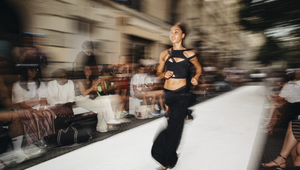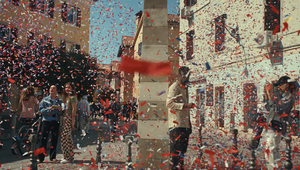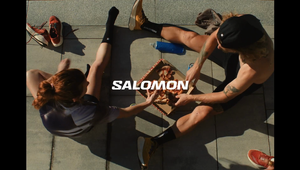
The Directors: Joris Bacquet

Joris is a versatile visual artist, renowned for his boundless creativity and multifaceted talents. His ability to navigate through various mediums and techniques has led him to collaborate with prestigious brands such as Issey Miyake, Dior, Guerlain, Orange, Renault, and many others.
What sets Joris apart is his early commitment to harnessing artificial intelligence in the realm of artistic creation. Before AI applications became mainstream, Joris was already exploring the possibilities offered by this innovative technology.
As an artist, Joris does not limit himself to technique alone. For him, the concept, whether visual or narrative, forms the cornerstone of his work, both in personal and professional projects. He views AI as a medium among others, a tool that allows him to explore new frontiers of creativity, both visually and narratively.
Name: BACQUET Joris
Location: France
Repped by/in: SOLDATS France
Awards: LIA (bronze award for weird wonderful work category)
LBB> What elements of a script sets one apart from the other and what sort of scripts get you excited to shoot them?
Joris> Everything for me starts with the concept. This is the cornerstone that gets me excited about a script at first. That’s the reason why I’m not restricting myself to a medium or a specific client market. Good ideas are for all clients, not only for the big ones. Second thing is execution. I like to challenge myself with new technical approaches or new ways of telling a story.
LBB> How do you approach creating a treatment for a spot?
Joris> It really depends on the pitch to be honest. But usually, the common element is that I start to visualise mental images of what I want to achieve for it. And starting from these mental jigsaw pieces, I’m starting to create the storytelling and fit them together. Sometimes it can be a wardrobe, a word of a song that leads me to a visual concept. It really depends on the basis, but it always starts with mental visualisation on my side.
LBB> If the script is for a brand that you're not familiar with/ don’t have a big affinity with or a market you're new to, how important is it for you to do research and understand that strategic and contextual side of the ad? If it’s important to you, how do you do it?
Joris> It really differs if you need to follow a brand legacy or if a client wants to break the codes. Usually what I’m taking care of is to not be disrespectful by bringing European culture and vision to a non-European client. I’m used to work for various overseas markets all around the world, and I think it’s important to immerse yourself into their own cultures but without losing your DNA and the reason why they chose you at first.
Regarding affinity, I think you don’t necessarily need to have it from scratch to do a good film. If you respect yourself as a creative person and don’t make the film for bad reasons, there’s no reason to not try bringing yourself into it.
The only thing I’m usually trying to avoid into the creative part is the marketing side of a job. I mean, thinking as a marketing person through the creative process can create limitations, boundaries to me. It’s important to consider creativity stronger than a marketing approach at first.
LBB> For you, what is the most important working relationship for a director to have with another person in making an ad? And why?
Joris> Before any DOP or art director or wardrobe stylist, I think the executive producer. I know it can sound cheesy or else but that’s the person who will push you further, believes in you and your ideas and will find ways to make it possible. I’m not saying that’s an all-time easy relationship but at least this is important to get him/her to push my work forward or to get me back to reality financially speaking. He/she’s the one helping you growing.
LBB> What type of work are you most passionate about - is there a particular genre or subject matter or style you are most drawn to?
Joris> Like I said above the most important thing to me is the concept and the step aside in the approach I can bring in. I’m not restricting myself to a specific business type of film or genre. I like when approaches are not the usual way for a specific market. “Moving the lines” that’s what I’m passionate about.
LBB> What misconception about you or your work do you most often encounter and why is it wrong?
Joris> Instead (in spite of?) of my real age, people think that I can only direct gen-z/ millennials films with graphics everywhere because of my CG graphic background mostly. But for me the medium must not define you or your work. Let’s be open-minded!
LBB> Have you ever worked with a cost consultant and if so how have your experiences been?
Joris> We’re always facing financial limitations and trying to find solutions to make things happen. But most of the time, it’s the executive producer who is directly confronted to the cost consultant and then gives us possibilities to bring our creative ideas to life.
LBB> What’s the craziest problem you’ve come across in the course of a production – and how did you solve it?
Joris> Problems are always part of the equation when you’re directing and not only during pre-production time. You need to move smart and fast when things happen on set. Everything is all about adaptation without losing the expected quality.
As an example, recently I shot with a robot arm, some anamorphosis effects that need to be done in real camera. We were not able timing and budget wise to do a proper 3D animated previsualisation for it before shooting. So during two nights before shooting I did the previz alone in my hotel room with some elements I found there. To get the good timing and camera movement I wanted, I used a metallic hanger to break it to make a flat metallic line symbolising the camera path that I can adjust easily by twisting it. I used some pens taped onto the floor to create some poles at the beginning and the end of the camera movement. Then I figured the camera with a forgotten marble I got in my luggage - thanks to my daughter. I taped the marble onto a small sewing thread on both ends creating an arch in the centre due to the marble weight. To figure set elements I used taped pieces of papers and created real basic shapes to figure a mic pole, a chair… that the camera must go over or turn around.
The marble was sliding onto the metallic line like a rigged camera with a visible path. The different measurements and timing I got from there, filmed with my phone, once converted to the real set dimensions, helped me to define camera positions and frame timing for it in real life with the real robot arm. Finally, it helps me to keep some time on set then by knowing already roughly where to put set objects, actors and camera.
LBB> How do you strike the balance between being open/collaborative with the agency and brand client while also protecting the idea?
Joris> I’m always trying to push forward a pitch. Showing agencies / clients that based on their original concept we can upgrade it in a more creative or unseen before ways.
On the agency/client side, sometimes they spend months already working on the script and finally succeed to approve it.
As a director, I need to keep it in mind, not being rude or too brutal by changing everything for no reason but at the same time doing my best to elevate it, bring my vision and freshness into the script.
Each client/creative team is different about the latitude they give you to handle a job.
It’s also important to keep in mind the client needs. It’s a commercial not a personal project. In the end, they need to sell a product, a lifestyle, an aspiration and sometimes you don’t have all the parameters in mind.
LBB> What are your thoughts on opening up the production world to a more diverse pool of talent? Are you open to mentoring and apprenticeships on set?
Joris> Creativity is everywhere and not related to your social status or any other studies level. Nowadays, technology allows each one of us, for a really low budget, to do what we want, to create things and unleash creative forms everywhere. If in the future I can help someone to understand our industry and what it really means to be a director (from pitch to delivery), of course I will be happy to do it.
LBB> How do you feel the pandemic is going to influence the way you work into the longer term? Have you picked up new habits that you feel will stick around for a long time?
Joris> As many other directors who usually work overseas, the pandemic was really painful. We were not allowed to fly anywhere. Remote shootings are not part of my best memories as a director for sure.
The thing that changed mostly is the way international clients and agencies are more open to do preproduction and postproduction remotely than before. It also helps to develop new ways of directing through new technology like XR studio, which expands possibilities and allows us to shoot even without flying overseas if a pandemic strikes again.
LBB> Your work is now presented in so many different formats - to what extent do you keep each in mind while you're working (and, equally, to what degree is it possible to do so)?
Joris> Usually, I’m keeping in mind thanks to safe frames in the monitor during shooting, vertical format at least and in worst case scenario square format. But to be honest when you need to start composing your framings related to many different formats, it becomes a nightmare as it restrains the global action and sometimes you end with a central acting only to be sure it fits different formats without losing the storytelling. Social media really changed the way we’re composing framings and sometimes, to be honest it’s a pity for creativity but that’s the way it is, so again adaptation and creativity is important.
LBB> What’s your relationship with new technology and, if at all, how do you incorporate future-facing tech into your work (e.g. virtual production, interactive storytelling, AI/data-driven visuals etc)?
Joris> I’m always looking for new opportunities of storytelling and expressing new conceptual approaches. I’m always trying to push further my boundaries and new technologies are part of it. For example, AI is just starting but creatively speaking it allows me to express myself in new ways, new aesthetics and most important new storytelling approaches. That’s the reason why I started to work with Ai back in October 2021, creating visuals with words was mind blowing to me. So, I went deeper into it and directed the world premiere narrative music video using AI as a medium and as a character. So new technology is really part of my process already. Being able to shoot in various international places or even virtual ones in one day thanks to XR studio facility or creating a fashion model who doesn’t exist at all and imagine virtual shooting with her in an alternative world is a great playground. Possibilities are endless like prompts alternatives. So why not embrace it instead of fearing it. I’m secretly dreaming of the moment when I’ll be able to “create” a music video thanks to only prompting it or parameterizing it specifically to what I want and then just by pressing the “calculate” button to create endless alternatives playing in real time. Time will tell.















